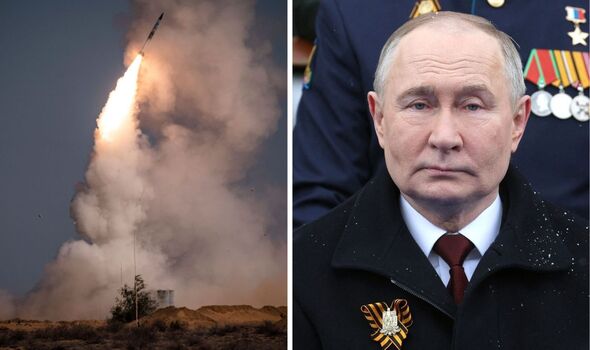Vladimir Putin flaunted nuclear weapons that can strike the UK in minutes on Thursday as Russia celebrated its annual Victory Parade.
The ‘Yars’ intercontinental ballistic missile launchers were pictured in Red Square alongside numerous other weapons of war as bloody fighting raged in Ukraine.
The patriotic pageantry for Victory Day is a celebration of the defeat of Nazi Germany in World War II that President Vladimir Putin has turned into a pillar of his nearly quarter-century in power and a justification for his move into Ukraine.
Even though few veterans of what Russia calls the Great Patriotic War are still alive 79 years after Berlin fell to the Red Army, the victory over Nazi Germany remains the most important and widely revered symbol of the country’s prowess and a key element of national identity.
Thursday’s festivities across Russia, led by Putin who this week began his fifth term in office, recall that wartime sacrifice in what has become its most important secular holiday.
“The Victory Day unites all generations,” Putin said in a speech at the Red Square parade. “We are going forward relying on our centuries-old traditions and feel confident that together we will ensure a free and secure future for Russia.”
He hailed the troops fighting in Ukraine for their courage and blasted the West, accusing it of “fueling regional conflicts, inter-ethnic and inter-religious strife and trying to contain sovereign and independent centres of global development.”
Amid Russia-West tensions that soared to the highest level since the Cold War times over Ukraine, Putin also issued another stark reminder about Russia‘s nuclear might.
“Russia will do everything to prevent global confrontation, but will not allow anyone to threaten us,” he said. “Our strategic forces are in combat readiness.”
The Soviet Union lost about 27 million people in the war, an estimate that many historians consider conservative, scarring virtually every family.
Nazi troops overran much of the western Soviet Union when they invaded in June 1941, before being driven back all the way to Berlin, where the USSR’s hammer and sickle flag was raised above the ruined capital. The US, UK, France and other allies mark the end of the war in Europe on May 8.
The immense suffering and sacrifice in cities like Stalingrad, Kursk and Putin’s native Leningrad – now St Petersburg – still serve as a powerful symbol of the country’s ability to prevail against seemingly overwhelming challenges.
Since coming to power on the last day of 1999, Putin has made May 9 an important part of his political agenda, featuring displays of military might. Columns of tanks and missiles roll across Red Square and squadrons of fighter jets roar overhead as medal-bedecked veterans join him to review the parade. Many wear the black-and-orange St George’s ribbon that is traditionally associated with Victory Day.
About 9,000 troops, including some 1,000 who fought in Ukraine, took part in Thursday’s parade.
Putin, 71, talks frequently about his family history, sharing memories of his father, who fought on the front during the Nazi siege of the city and was badly wounded.
As Putin tells it, his father, also named Vladimir, came home from a military hospital during the war to see workers trying to take away his wife, Maria, who had been declared dead of starvation. But the elder Putin did not believe she had died – saying she had only lost consciousness, weak with hunger. Their first child, Viktor, died during the siege when he was 3, one of more than 1 million Leningrad residents who died in the 872-day blockade, most of them from starvation.
For several years, Putin carried a photo of his father in Victory Day marches – as did others honouring relatives who were war veterans – in what was called the “Immortal Regiment.”
Those demonstrations were suspended during the coronavirus pandemic and then again amid security concerns after the start of the fighting in Ukraine.
As part of his efforts to burnish the Soviet legacy and trample on any attempts to question it, Russia has introduced laws that criminalised the “rehabilitation of Nazism” that include punishing the “desecration” of memorials or challenging Kremlin versions of World War II history.
